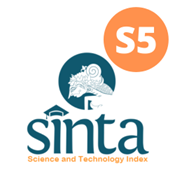Toponymy of Garden Names at Lahu Village
(1) Universitas Kristen Indonesia Tomohon
(*) Corresponding Author
DOI: https://doi.org/10.26858/phonologie.v2i2.35305
Abstract
Abstract. This study aims to analyze the lingual form and to describe the phenomenon of naming place in Lahu village, Talaud regency, North Sulawesi Province with Talaud language as the object. Naming places refers to ethno linguistics study, a study that examining language and history. When it is formed, where it comes from, and what the reasons for naming it often become the main topics in research. For the purpose of analysis, the researcher examines the lingual form and the process of word formation. After that, the writer describes the determinant factors of naming places. This is a qualitative study with descriptive approach. In collecting data, the researcher uses listening and speaking method from Mahsun (2005). The listening method is used to collect data in the lingual form and phenomenon of naming place which appear in a speech. The Padan and Distribution are the method used to analysis data. These method process two data analyzing techniques, namely (1) Intralingual and (2) Technique of analyzing the smallest element. According to the research result, stem dominates the naming of places beside caused by affixation, reduplication and composition. For example: Niure [niure] ‘took back, Soa [soa] ‘vilage, Tatarangan [tataraµan] ‘track’, Linturran [incline] ‘turunan’, Ritawu [ritawu] ‘lose track’, Wawombatu, [wawombatu] ‘rock hill’, Panentean [panentean] ‘hillside, Nato [nato] ‘wood Nyato or Nato. Name of the land with the above lingual form is identity of the location. It is an inseparable part of a process. It is believed that naming a place is part of ancestral experience that has attempted to mark and to give identity on every known land location. In terms of naming place domination, the writer finds seven dominations. They are soil structure, plants, lake, process of morphologies, history, adjective, and object.
Kata kunci: Toponymy, Talaud Language, Lahu
Full Text:
PDFReferences
Alwasilah, C. (2002). Pokoknya Kualitatif: Dasar-dasar Merancang dan Melakukan Penelitian Kualitatif. Jakarta: PT Kiblat Utama.
Alwasilah, C. (1993).Linguistik Suatu Pengantar. Bandung: Angkasa.
Berger, P. L. dan Thomas, L. (1990). Tafsir Sosial Atas Kenyataan. Risalah Tentang Sosiologi Pengetahuan. Jakarta: LP3ES.
Chaer, A. (2003). Linguistik Umum. Jakarta: Rineka Cipta.
Crystal, D. (1982). The Cambridge Encyclopedia of Language. New York: Cambridge University Press.
Djajasudarma, F. (1993). Metode Linguistik.Bandung: Rafika Aditama.
Duranti, A. (1997). Linguistic Anthropology. Cambridge: Cambridge University Press.
Foley, W. A. (1997). Anthropological Linguistics: An Introduction. Oxford: Blackwell Published
Halliday, M.A.K. (1978). Language and Social Semiotics: The Social Interpretation of Language and Meaning. London: Edward Arnold.
https://www.google.com/maps/search/lahu/@4.4320923,126.8584752,15z
Kridalaksana, H. (2008). Pembentukan Kata Dalam Bahasa Indonesia. Jakarta: PTGramedia Pustaka Utama.
Mahsun, M. S. (2005). Metode Penelitian Bahasa. Tahapan Strategi, Metode, dan Tekniknya. Jakarta: PT Raja Grahindo Persada.
Mortimer, J. A. (1996). Great Books of the Western World. Encyclopedia Britannica the 6thed. London: UCL. Press.
Nida, E. A. (1970). Morphology, The Deskriptive Analysis of Word. Michigan: The University of Michigan Press.
Riana, I K. (2003). “Linguistik Budaya: Kedudukan dan Ranah Pengkajiannya”, dalam Pidato Pengukuhan Guru Besar Tetap pada Fakultas Sastra, Universitas Udayana. Denpasar: Universitas Udayana.
Sausure, F de. (1988). Pengantar Linguistik Umum. Penerjemah: Hidayat. R. S. Yogyakarta: Gajahmada University Press.
Shadily, H. (1982). Sosiologi Untuk Masyarakat Indonesia. Jakarta: Bina Aksara.
Spradley, J. P. (1997). Metode Etnografi. Jogyakarta: PT. Tiara Wacana Yogya.
Subroto, E. (2007). Pengantar Metode Penelitian Struktural. Surakarta: Lembaga Pengembangan Pendidikan (LPP) UNS dan UPT Penerbitan dan Percetakan UNS (UNS Press).
Sudaryanto. (1990). Fungsi Hakiki Bahasa. Yogyakarta: Duta Wacana University Press.
Yule, G. (1996). Pragmatik. Terjemahan Indah Fajar Wahyuni dan Rombe Mustajab. 2006. Yogyakarta: Pustaka Pelajar
Article Metrics
Abstract view : 198 times | PDF view : 29 timesRefbacks
- There are currently no refbacks.














